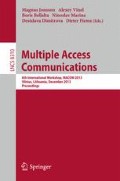Abstract
In this paper we investigate the problem of designing a spectrum multi-step scanning strategy to detect an intelligent Invader who wants to utilize spectrum undetected for his/her unapproved purposes. To deal with this problem, we model it as a two stage game, along with specifying an algorithm of scanning the spectrum and evaluating the stationary bandwidth of spectrum to scan. The game is solved explicitly and reveal interesting properties. In particular, we have found a discontinuous dependence of the equilibrium strategies on the network parameters, fine and the Invader’s intention for illegal activity, which can lead even to multi-equilibrium situation. To select a proper equilibrium strategy the best response strategy algorithm can be applied which in the multi-equilibria case always converges for a finite number of iteration, meanwhile for mono-equilibria situation it does not converge, circling around the equilibrium. Also, we have shown that the detection probability and payoffs in some situation can be very sensible to fine and the Invader’s intention to intrude into the network longer, what yields that the network provider has to carefully make a value judgement of fine and estimation of the Intruder’s intentions.
Access this chapter
Tax calculation will be finalised at checkout
Purchases are for personal use only
Preview
Unable to display preview. Download preview PDF.
References
Haykin, S.: Cognitive radio: brain-empowered wireless communications. IEEE Journal on Selected Areas in Communications 23, 201–220 (2005)
Mitola, J.: Cognitive radio for flexible mobile multimedia communications. In: IEEE International Workshop on Mobile Multimedia Communications, pp. 3–10 (1999)
Akyildiz, I.F., Lee, W.Y., Vuran, M.C., Mohanty, S.: Next generation/dynamic spectrum access/cognitive radio wireless networks: a survey. Computer Networks 50, 2127–2159 (2006)
Fette, B.A.: Cognitive radio technology. Academic Press, NY (2009)
Liu, S., Chen, Y., Trappe, W., Greenstein, L.J.: ALDO: An anomaly detection framework for dynamic spectrum access networks. In: INFOCOM 2009, pp. 675–683 (2009)
Verdu, S.: Multiuser detection. Cambridge Univ. Press (1998)
Van Trees, H.L.: Detection, Estimation, and Modulation Theory, Radar-Sonar Signal Processing and Gaussian Signals in Noise. Wiley-Interscience (2004)
Digham, F.F., Alouini, M.S., Simon, M.K.: On the energy detection of unknown signals over fading channels. IEEE Transactions on Communications 55, 21–24 (2007)
Urkowitz, H.: Energy detection of unknown deterministic signals. Proceedings of the IEEE 55, 523–531 (1967)
Garnaev, A., Trappe, W., Kung, C.-T.: Dependence of Optimal Monitoring Strategy on the Application to be Protected. In: IEEE GlobeCom 2012, pp. 1072–1077 (2012)
Garnaev, A., Trappe, W., Kung, C.-T.: Optimizing Scanning Strategies: Selecting Scanning Bandwidth in Adversarial RF Environments. In: Crowncom 2013 (2013)
Liu, Y., Comaniciu, C., Man, H.: A Bayesian game approach for intrusion detection in wireless Ad Hoc networks. In: GameNets 2006 (2006)
Agah, A., Das, S.K., Basu, K., Asadi, M.: Intrusion detection in sensor networks: A non-cooperative game approach. In: NCA 2004, pp. 343–346 (2004)
Garnaev, A.: Remark on the Princess and Monster Search Game. International Journal of Game Theory 20, 269–276 (1992)
Garnaev, A., Garnaeva, G., Goutal, P.: On the Infiltration Game. International Journal of Game Theory 26, 215–221 (1997)
Manshaei, M.H., Zhu, Q., Alpcan, T., Basar, T., Hubaux, J.-P.: Game theory meets network security and privacy. J. ACM Computing Survey 453 (2013)
Owen, G.: Game Theory. W.B. Sanders, Philadelphia (1982)
Zhu, Q., Saad, W., Han, Z., Poor, H.V., Basar, T.: Eavesdropping and Jamming in Next-Generation Wireless Networks: A Game-Theoretic Approach. In: MILCOM 2011, pp. 119–124 (2011)
Altman, E., Avrachenkov, K., Garnaev, A.: Taxation for green communication. In: WiOpt 2010, pp. 108–112 (2010)
Sagduyu, Y.E., Ephremides, A.: A Game-Theoretic Analysis of Denial of Service Attacks in Wireless Random Access. Journal of Wireless Networks 15, 651–666 (2009)
Garnaev, A., Hayel, Y., Altman, E., Avrachenkov, K.: Jamming Game in a Dynamic Slotted ALOHA Network. In: Jain, R., Kannan, R. (eds.) GameNets 2011. LNICST, vol. 75, pp. 429–443. Springer, Heidelberg (2012)
Garnaev, A.: On a Ruckle problem in discrete games of ambush. Naval Research Logistics 44, 353–364 (1997)
Altman, E., Avrachenkov, K., Garnaev, A.: Jamming in Wireless Networks: the Case of Several Jammers. In: GameNets 2009, pp. 585–592 (2009)
Altman, E., Avrachenkov, K., Garnaev, A.: Transmission Power Control Game with SINR as Objective Function. In: Altman, E., Chaintreau, A. (eds.) NET-COOP 2008. LNCS, vol. 5425, pp. 112–120. Springer, Heidelberg (2009)
Kim, S.L., Rosberg, Z., Zander, J.: Combined power control and transmission rate selection in cellular networks. In: IEEE VTC 1999, pp. 1653–1657 (1999)
Koo, I., Ahn, J., Lee, H.A., Kim, K.: Analysis of Erlang capacity for the multimedia DS-CDMA systems. IEICE Trans. Fundamentals E82-A(5), 849–855 (1999)
Altman, E., Avrachenkov, K., Garnaev, A.: Closed Form Solutions for Water-Filling Problem in Optimization and Game Frameworks. Telecommunication Systems Journal 47, 153–164 (2011)
Comaniciu, C., Mandayam, N.B., Poor, H.V.: Wireless Networks Multiuser Detection in Cross-Layer Design. Springer, Heidelberg (2005)
Author information
Authors and Affiliations
Editor information
Editors and Affiliations
Rights and permissions
Copyright information
© 2013 Springer International Publishing Switzerland
About this paper
Cite this paper
Garnaev, A., Trappe, W. (2013). Stationary Equilibrium Strategies for Bandwidth Scanning. In: Jonsson, M., Vinel, A., Bellalta, B., Marina, N., Dimitrova, D., Fiems, D. (eds) Multiple Access Communcations. MACOM 2013. Lecture Notes in Computer Science, vol 8310. Springer, Cham. https://doi.org/10.1007/978-3-319-03871-1_15
Download citation
DOI: https://doi.org/10.1007/978-3-319-03871-1_15
Publisher Name: Springer, Cham
Print ISBN: 978-3-319-03870-4
Online ISBN: 978-3-319-03871-1
eBook Packages: Computer ScienceComputer Science (R0)

